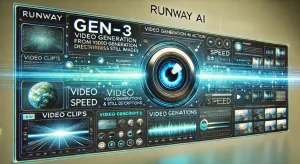Runway’s Gen-3 Alpha AI: Revolutionizing Video Creation with Advanced Controls
The competition for high-quality, AI-generated video creation is intensifying, with companies striving to push the boundaries of what’s possible. At the forefront of this innovation is a leader in generative AI tools designed specifically for filmmakers and content creators. The company recently unveiled its latest model, Gen-3 Alpha, marking a new era in AI-driven video creation. This state-of-the-art model not only generates video clips from text descriptions and still images but does so with a level of speed and fidelity that surpasses its predecessor, Gen-2. With Gen-3 Alpha, creators gain advanced controls over the structure, style, and motion of videos, allowing unprecedented freedom in their artistic endeavors.
Advanced Features and Availability
Runway’s Gen-3 Alpha will be available soon to its subscribers, including enterprise customers and members of its creative partners program. According to Runway, Gen-3 excels at creating expressive human characters, showcasing a wide range of actions, gestures, and emotions. It can interpret various styles and cinematic terms, enabling imaginative transitions and precise key-framing of elements in a scene.
However, despite its many advancements, Gen-3 Alpha is not without its limitations. The generated video clips are currently capped at 10 seconds in length, and the model can struggle with rendering complex interactions and realistic physics. Nonetheless, Runway’s co-founder, Anastasis Germanidis, has reassured users that Gen-3 Alpha is only the first in a series of next-generation models built on a significantly upgraded infrastructure. The initial rollout will support the generation of 5- and 10-second high-resolution clips, with faster generation times compared to the Gen-2 model. This suggests that future iterations of Gen-3 could offer even greater capabilities and fewer limitations.
Training Data and Ethical Considerations
The development of Gen-3 Alpha involved training the model on an extensive dataset of videos and images, enabling it to learn patterns and generate new clips that are both realistic and visually appealing. However, the company has chosen not to disclose the specific sources of its training data, a decision that aligns with industry practices among generative AI vendors. This approach is intended to protect competitive advantages and avoid potential intellectual property issues. Nevertheless, the lack of transparency raises important questions about the ethical implications of using such data, particularly in relation to copyright and the fair use of content.
The team behind Gen-3 Alpha has emphasized its collaboration with artists in developing the model, aiming to address copyright concerns proactively. The company plans to release the model with a new moderation system designed to prevent the generation of videos that feature copyrighted content or violate terms of service. Additionally, they will implement a provenance system compatible with the C2PA (Coalition for Content Provenance and Authenticity) standard. This system will help verify the authenticity of media created with Gen-3 models, ensuring that as the model’s capabilities improve, alignment and safety efforts keep pace. This is particularly important as the industry grapples with the ethical challenges posed by increasingly sophisticated AI tools.
Industry Impact and Collaboration
The company’s influence extends beyond its technology; it has forged partnerships with leading entertainment and media organizations to develop custom versions of Gen-3 Alpha. These collaborations aim to provide more stylistically controlled and consistent characters tailored to specific artistic and narrative needs. However, despite these advancements, controlling generative models to fully align with a creator’s artistic vision remains a significant challenge. Often, extensive manual work by editors is required to achieve the desired outcome, highlighting the current limitations of even the most advanced AI tools.
In addition to its technological contributions, the company is closely aligned with the creative industry. It has raised over $236.5 million from investors, including tech giants Google and Nvidia, underscoring the significant financial backing behind its innovations. The company also operates an entertainment division dedicated to exploring the intersection of AI and filmmaking. Furthermore, it hosts an AI Film Festival, an event that showcases films produced with AI tools, providing a platform for creators to experiment with and showcase the potential of generative AI in storytelling.
Rising Competition
The market for generative AI video tools is becoming more competitive. Luma recently introduced Dream Machine, a video generator known for animating memes, while Adobe is developing a video-generating model trained on its Adobe Stock media library. OpenAI’s Sora, although still in limited release, has gained attention from marketing agencies and filmmakers, including those at the Tribeca Festival. Google’s image-generating model, Veo, is also making strides, with creators like Donald Glover using it for projects.
Future of the Industry
The advent of generative AI video tools is poised to have a profound impact on the film and television industry. Filmmaker Tyler Perry, for example, has reconsidered a major studio expansion after witnessing the capabilities of AI tools like Sora. Joe Russo, the director of Marvel’s “Avengers: Endgame,” has gone so far as to predict that artificial intelligence will soon be capable of creating a full-fledged movie.
This prediction is supported by a study conducted by the Animation Guild, which found that AI adoption has already led to job reductions in film production. The study estimates that over 100,000 U.S. entertainment jobs could be disrupted by 2026, highlighting the need for strong labor protections to prevent AI tools from causing steep declines in creative employment.
As generative AI continues to evolve, the industry will need to carefully consider the ethical and employment implications of these technologies. While AI-driven tools like Gen-3 Alpha offer exciting new possibilities for video creation, they also present challenges that must be addressed to ensure that the benefits of these innovations can be harnessed without sacrificing jobs or creative integrity.
Runway now allows you to create AI videos using prompts of up to 1,000 characters
Runway stands out as a leading AI video generator, especially with its recent update allowing prompts of up to 1,000 characters. Each AI model varies in how it interprets prompts; some thrive on lengthy, intricate requests, while others prefer concise, focused inputs. Runway strikes a balance, encouraging specificity yet also valuing brevity. To evaluate the necessity of utilizing the full 1,000 characters for achieving impressive realism and motion, I developed several concepts and crafted both short and long prompts in accordance with Runway’s guidelines. For this experiment, I focused solely on text-based prompts, despite my preference for image-to-video, as it offers greater output control. Runway still delivers excellent image quality with text-to-video.
Conclusion
Runway’s Gen-3 Alpha represents a significant step forward in AI-generated video creation, offering improved controls, faster generation times, and a range of advanced features that set it apart from previous models. As the competition in the generative AI video market intensifies, the impact of these tools on the entertainment industry will only grow. However, with this growth comes the responsibility to navigate the ethical and employment challenges that arise. By doing so, the industry can ensure that the transformative potential of AI is realized in a way that benefits both creators and audiences alike.







